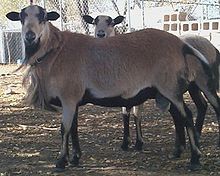Type the name of the breed you're looking for below
[wpdreams_ajaxsearchlite] Don't see the breed your're looking for? Click here and let us know!
Barbados Blackbelly sheep
| Place of Origin | Caribbean |
| Origin | The Barbados Blackbelly sheep is a breed of domestic sheep that was developed in the Caribbean. Although it is likely the Barbados Blackbelly has African ancestry, there seems to be clear evidence that the breed, as seen today, was developed by the people on the island from sheep brought by ships fairly early in the period after Europeans first arrived. This breed is raised primarily for meat. In 1904, the USDA imported a small flock and transported them for study to Bethesda, Maryland. From that original flock, at least two distinct breeds have emerged in the U.S., and there is a great deal of confusion in the breed names. In 2004, there were fewer than 200 purebred Barbados Blackbelly sheep in the U.S., in contrast to a large and growing population of a popular crossbreed, commonly referred to as "Barbado." Whereas purebred Barbados Blackbelly and ewes are polled (hornless), the Barbado is most noted for the regal rack of horns on the rams, and some ewes may also have small horns. The horns were gained by crossbreeding Barbados Blackbelly with Mouflon and Rambouillet early after they were imported by the USDA. The rams with large horn curl are commercially bred for use on private hunting ranches where size of horn curl is prized by exotic game hunters. |
| Purpose | Meat |
| Characteristics | Blackbelly sheep of both breeds are able to tolerate heat and exhibit more stamina than most breeds of sheep. They are fleet of foot and in many ways resemble deer. They are "hair sheep," which means they do not grow wool but have coarse hair instead. If raised in cooler climates, they often develop a wool undercoat that they shed in the spring. Barbados Blackbelly sheep will breed all year round unlike most domestic sheep. Because they are smaller and slower growing than most wooled sheep, they are not a good choice for commercial production. However, there is a strong market for their lean and mild-flavored meat, and they are popular with herding dog trainers. They are very disease resistant and parasite tolerant, and these genetic traits have created a demand for Blackbelly sheep in crossbreeding operations. These exotic-looking sheep are a perfect choice for a homesteader's sheep because they do relatively well on poorer forage, can be raised with very little grain, and do not require intensive management. Blackbelly sheep range in colour from light tan to a dark mahogany red, with black stripes on the face and black legs, belly, inguinal region, chin, and chest, which gives this herbivore its name. Despite being goat-like in appearance, they are true sheep. |
| Other Considerations | Recognizing that the term "Barbado" did not adequately define the characteristics that breeders sought in the horned animal, the Barbados Blackbelly Sheep Association International (BBSAI) adopted a breed standard in 2004 and defined animals meeting this standard as "American Blackbelly." As a result, breeders of both breeds of sheep were better able to obtain genetics of their breed of choice with some certainty that the animals would breed to type. In 2014, there were more than 1,900 registered Barbados Blackbelly sheep in the U.S., and although the breed is not out of danger, it is far more stable than it has ever been in the U.S. There are two breed registries in North America for Blackbelly sheep. The Barbados Blackbelly Sheep Association International (BBSAI) welcomes both Barbados Blackbelly and American Blackbelly and has registries for both. Both registries are closed, meaning that only sheep whose parents are registered can be registered themselves. There are over 3,500 sheep registered with the BBSAI. The North American Barbados Blackbelly Sheep Registry primarily registers the horned Blackbelly sheep. |



